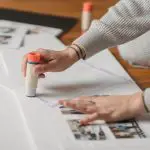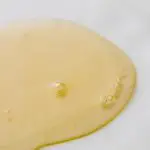Hey there, ever found yourself in a sticky situation with Gorilla Glue on your favorite fabrics? Don't worry, we've got you covered.
In this guide, we'll explore 5 effective methods to soften Gorilla Glue from fabrics, allowing you to masterfully rescue your cherished items.
From the heat and scrape technique to professional dry cleaning services, these proven methods will help you restore your fabrics to their former glory.
So, if you're ready to tackle this challenge with finesse, let's dive in and learn how to soften Gorilla Glue on fabrics like a pro.
Key Takeaways
- Heat-based methods can be effective in softening Gorilla Glue on fabrics, but caution must be taken to avoid fabric damage.
- Solvent-based methods using adhesive removers can help break down the glue, but it is important to consider chemical compatibility with the fabric and follow manufacturer instructions.
- The acetone soaking method can be highly effective, but it may not work on all fabric types, so testing on a small area is recommended.
- Freezing and peeling is a technique that can be used for fabrics that may not react well to solvents or heat, and it involves placing the fabric in a sealed plastic bag in the freezer and then carefully peeling off the hardened glue.
Heat and Scrape Method
To soften Gorilla Glue on fabrics, you can start by applying heat to the affected area and then carefully scraping off the softened adhesive using a putty knife or similar tool. Heating the glue helps to weaken its bond with the fabric, making it easier to remove. You can use a hairdryer or a heat gun on a low setting to gently warm the glue. Keep the heat source moving to avoid damaging the fabric. Once the glue is warm and pliable, use the putty knife to gently scrape it off. Be cautious not to press too hard to avoid damaging the fabric fibers.
When opting for chemical-free alternatives, the heat and scrape method is an effective and environmentally friendly approach to soften and remove Gorilla Glue from fabrics. It eliminates the need for harsh chemicals and solvents, making it a safer option for both you and the environment. This method requires patience and careful attention to detail but can be highly successful in restoring the fabric to its original state without causing any harm.
Solvent-Based Adhesive Removers
You can start by applying a solvent-based adhesive remover to the affected area and allowing it to penetrate the Gorilla Glue on the fabric for the recommended time. When using solvent-based adhesive removers, it's important to consider chemical compatibility with the fabric to avoid causing damage.
Here are some safety precautions to keep in mind when using solvent-based adhesive removers:
- Always read and follow the instructions provided by the manufacturer of the adhesive remover.
- Ensure good ventilation in the area where you're working to avoid inhaling potentially harmful fumes.
- Wear protective gloves and goggles to prevent skin contact and eye irritation.
- Test the adhesive remover on a small, inconspicuous area of the fabric first to ensure that it doesn't cause any adverse reactions.
Soaking in Acetone Solution
When dealing with Gorilla Glue on fabrics, consider soaking the affected area in an acetone solution to help soften and remove the adhesive. Acetone is a powerful solvent that can effectively break down the bond of Gorilla Glue on fabrics. However, it's important to take precautions and ensure fabric compatibility before using acetone. Here's a table to help you understand the process better:
| Considerations | Details |
|---|---|
| Acetone precautions | Work in a well-ventilated area and wear gloves to protect your skin. Avoid using acetone near open flames. |
| Fabric compatibility | Acetone can damage some fabrics, so it's crucial to test it on a small, inconspicuous area first. Avoid using acetone on delicate or synthetic fabrics. |
| Soaking duration | Soak the affected area for 30-60 minutes, checking periodically to see if the adhesive has softened. |
| Effectiveness | Acetone is highly effective in softening Gorilla Glue, making it easier to remove from fabrics. However, it may not work well on all fabric types. |
Freezing and Peeling Technique
After soaking the affected area in an acetone solution, assess the fabric for compatibility and then proceed with the freezing and peeling technique to further soften and remove Gorilla Glue from fabrics.
To effectively utilize the freezing and peeling technique, follow these steps:
- Place the fabric in a sealable plastic bag, ensuring the affected area is easily accessible.
- Seal the bag and put it in the freezer for at least 2-3 hours. The cold temperature will cause the glue to harden and become brittle.
- Remove the bag from the freezer and carefully peel off the hardened glue using a blunt tool, such as a butter knife or a spoon. Be gentle to avoid damaging the fabric.
- If the glue remains stubborn, repeat the freezing and peeling process until the majority of the adhesive is removed.
This method is particularly useful for fabrics that may not react well to solvents or heat. It allows for a gentle and non-invasive approach to softening and eliminating Gorilla Glue from various fabric types, ensuring fabric compatibility and minimizing the risk of damage.
Professional Dry Cleaning Services
Once the freezing and peeling technique has been attempted, if the Gorilla Glue persists on delicate or special fabrics, consider seeking professional dry cleaning services for safe and effective removal. Professional dry cleaners have the expertise and specialized equipment to handle tough fabric stains like Gorilla Glue while ensuring fabric protection. They use industry-approved stain removal techniques that are gentle on delicate fabrics yet powerful enough to eliminate stubborn adhesives. Here's a comparison of DIY vs. professional dry cleaning services:
| Aspect | DIY | Professional Dry Cleaning |
|---|---|---|
| Expertise | Limited | Extensive |
| Fabric Protection | Risk of damage | Ensured |
| Stain Removal | Variable results | Consistent effectiveness |
| Equipment | Household supplies | Specialized machinery |
| Convenience | Time-consuming | Efficient and convenient |
For Gorilla Glue or any other challenging fabric stains, professional dry cleaning services offer a reliable solution with a focus on fabric protection and effective stain removal.
Frequently Asked Questions
Can I Use a Hairdryer or Heat Gun to Soften Gorilla Glue on Fabrics?
You can use a hairdryer or heat gun to soften Gorilla Glue on fabrics. Apply heat to the affected area and gently peel or scrape off the softened glue. Be cautious and test a small area first.
Is It Safe to Use Nail Polish Remover or Acetone Nail Polish Remover to Remove Gorilla Glue From Fabrics?
It's not safe to use nail polish remover or acetone on fabrics with Gorilla Glue. Alternative solvents like isopropyl alcohol or vinegar are safer options. Always test in a small, hidden area first and wear protective gloves.
Can I Soak the Fabric in a Vinegar Solution to Soften Gorilla Glue?
Soaking the fabric in a vinegar solution may help soften Gorilla Glue. However, be cautious as it may not fully dissolve the adhesive. Consider using a heat gun or hairdryer to gently warm the area for better results.
Will Using an Ice Pack or Frozen Cloth Help Soften Gorilla Glue on Fabrics?
Using freezing methods like an ice pack or frozen cloth may not significantly soften Gorilla Glue on fabrics. Chemical reactions are not typically affected by cold temperatures. Consider using solvents or heat for better results.
Are There Any Specialized Dry Cleaning Services That Specialize in Removing Gorilla Glue From Fabrics?
If you're dealing with Gorilla Glue on fabrics, specialized dry cleaning services with expertise in fabric restoration and professional fabric cleaning can effectively address Gorilla glue removal. Seek out professionals experienced in handling such issues for optimal results.
- Chemistry's Role in Fabric Production - July 25, 2024
- Moisture Management in Modern Fabrics - July 25, 2024
- Engineering Fabrics for Optimal Performance - July 25, 2024








